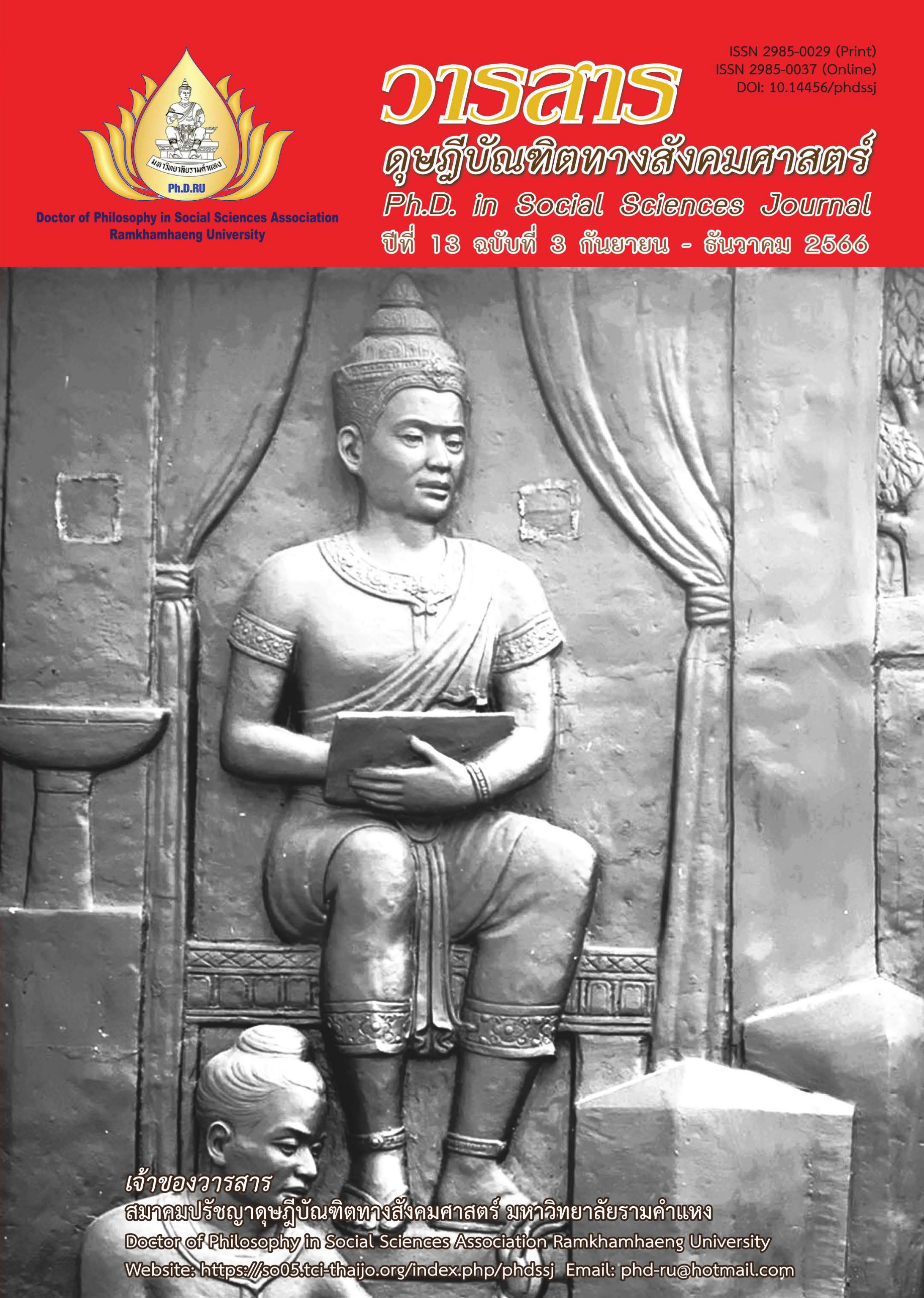Factors Influencing the Efficiency of Community Enterprise Management in the Upper Northeastern Region of Thailand
Main Article Content
Abstract
This research article aims to study (1) the process of managing successful community enterprise groups and (2) the factors that influence the efficiency of managing community enterprise groups that have received quality certification. It is survey research. Using questionnaires to collect data. There were 2 sample groups of community enterprises: 48 groups that were successful and 432 groups that received quality certification. Statistics used in data analysis included percentages, means, and standard deviations. and structural equation model analysis.
Findings are as follows: That the successful group supported by the government, 65 members on 9 years average with share capital stock average at 103,951.82 baht, structured according to duties, sincere, unity, honest, transparency, also leader from election, stock dividend at 5-30%, meeting 1-2 times/year, with money valuable and non-valuable cost. Production according to customer orders, non-toxic, clean, safe home stay. Quality assurance group, Government support, training and efficiency of Capital management, it has a positive influence on production management efficiency, consistent with empirical data Statistically significant at the .05 level with a p-value of 0.094. The variables in the model can explain 59.00 percent of the variance in production efficiency.
Article Details

This work is licensed under a Creative Commons Attribution-NonCommercial-NoDerivatives 4.0 International License.
Academic articles, research articles, and book reviews in the Ph.D. in Social Sciences Journal are author’s opinions, and not the publisher’s, and is not the responsibility of the Ph.D. in Social Sciences Journal Philosophy Association, Ramkhamhaeng University. (In the case that research is done on human, the researcher has to be trained in Ethics for Doing Research on Human Training and has to produce the evidence of the training).
References
Apiprachayasakul. K. (2014). Production management. Focus Media and Publishing. [In Thai]
Barretta, A., & Busco, C. (2011). Technologies of government in public sector’s networks: In search of cooperation through management control innovations. Management Accounting Research, 22(4), 211-219.
Boonchorm, S. (2018). Analytical economics. University Rajamangala Isan Technology Kalasin Campus, Faculty of Social Technology. [In Thai]
Bouma, J., Bulte, E., & Van Soest, D. (2008). Trust and cooperation: Social capital and community resource management. Journal of Environmental Economics and Management, 56(2), 155-166.
Cankar, S.S., Seljak, J., & Petkovšek, V. (2014). Factors that influence cross-border cooperation between businesses in the Alps-Adriatic region. Economic Research-Ekonomska Istraživanja, 27(1), 304-319.
Chiarakul, T. (2014). The problems and the adaptation of OTOP to AEC. Executive Journal, 34(1), 177-191. [In Thai]
Community Organization Development Institute. (2016). Handbook for supporting economic system development and community capital. Author. [In Thai]
Department of Agricultural Extension, Community Enterprise Promotion Division. (2021). Community enterprise support. Retrieved from http://www.sceb.doae.go.th [In Thai]
Drucker, P. F. (2019) The meaning of efficiency. Retrieved from https://www.se-ed.com/product-search [In Thai]
Electronic Transactions Development Agency. (2021). Government roles in supporting e-commerce. Retrieved from https://www.etda.or.th/th/UsefulResource/Government-Support [In Thai]
Hair, J. F., Sarstedt, M., Pieper, T. M., & Ringle, C. M. (2012). The use of partial least squares structural equation modeling in strategic management research: a review of past practices and recommendations for future applications. Long Range Planning, 45(5-6), 320-340.
Kaewchamnong, A. (2009). Principles of management (2nd ed.). Nam Silpa. [In Thai]
Kanchanapibul, C. (2019). Introduction to accounting. Vocational Promotion Center. [In Thai]
Kunthonbutr, C. (2013). Principle of management organization and modern management. Chulalongkorn University Press. [In Thai]
Lagkum, N. (2020). Impact of learning orientation and sustainable product development through efficiency of capital management and marketing management of community enterprises in the Upper Northeastern Region. Journal of Burapha Pisut College of Commerce, 15(2), 135-149. [In Thai]
Mahaphasuthanon, T. (2011). Principles of management. PNK & Sky. [In Thai]
Maharatsakul, P. (2008). Human resource management towards the future (2nd ed.). Pim Tawan. [In Thai]
Marketing Working Thailand. (2020). The definition of production efficiency. Author [In Thai]
NocNoc-An Online Marketplace for Materials and Home Furnishings, Complete Installation. (2021). Marketing efficiency. Retrieved from https://hmong.in.th/wiki/Marketing [In Thai]
Nunnally, J. C. (1978). Psychometric theory. McGraw-Hill.
Office of the Secretary of the Community Enterprise Promotion Committee. (2005). Meaning of community enterprise. Retrieved from https://smce.doae.go.th/smce1/index.php?result=5 [In Thai]
Oricha, J. Y., & Olarinoye, G. A. (2012). Analysis of interrelated factors affecting efficiency and stability of power supply in Nigeria. International Journal of Energy Engineering, 2(1), 1-8.
Pitaksarn, S. (2013). Factors affecting the success of the implementation of the enterprise promotion policy community implementation: A case study of Mueang Krabi district, Krabi province. Journal of Academic Resources, 24(3), 33-46. [In Thai]
Punroob, J., Duangjai, E., & Kanthiya, A. (2021). Casual factors influencing for competitive advantage of the product from community enterprise, Mueang District, Nan Province. Ph.D. in Social Sciences Journal, 11(2), 520-535. [In Thai]
Rattanapiboon, A. (n.d.). Group management does not cause anxiety. Retrieved from http://www.gotoknow.org/posts [In Thai]
Red Cyber Club. (2009). OTOP path to OVOP, secret to success. Retrieved from http://redcyberkid.blogspot.com [In Thai]
Romano, P., & Vinelli, A. (2001). Quality management in a supply chain perspective: strategic and operative choices in a textile-apparel network. International Journal of Operations & Production Management, 21(4), 446-460.
Schumacker, R. E., & Lomax, R. G. (2010). A beginners guide to structural equation modeling. Routledge.
Srimahaprom, W. (n.d.). Introduction to marketing. Retrieved from https://sites.google.com/site/groupmarketingsites/chxng-thangkar-tlad-page1 [In Thai]
Sudprasert, P. (n.d.). Quality management in the organization. Retrieved from https://sites.google.com/site/rtech603xx/unit-6 [In Thai]
Sukmanee, P. (2018). Principles of economics. Rajamangala University of Technology Isaan Kalasin Campus, Faculty of Social Technology. [In Thai]
Surangsrirat, T., Krimjai, N., Deesukanan, C., & Kositkanin, C. (2021). Influence of causal factors on competitive advantage for One Tambon One Product (OTOP) manufacturer in Thailand. Ph.D. in Social Sciences Journal, 11(2), 321-337. [In Thai]
Teerakul, N., Wiboonpong, A., & Sriboonchit, S. (2014). Process self-reliance of agricultural communities towards OVOP and lessons for Thai OTOP. Chiang Mai University. Retrieved from http://www.mcc.cmu.ac.th [In Thai]
Theppawan, P. (2012). A-Z Modern human resource management tools. V. Print (1991). [In Thai]
Waiwanitkul, N., & Udomsri. N. (2011). Business research methodology. Chulalongkorn University Press. [In Thai]
Wikipedia. (2009). The meaning of capital. Retrieved from https://th.wikipedia.org/wiki/ทุน [In Thai]


